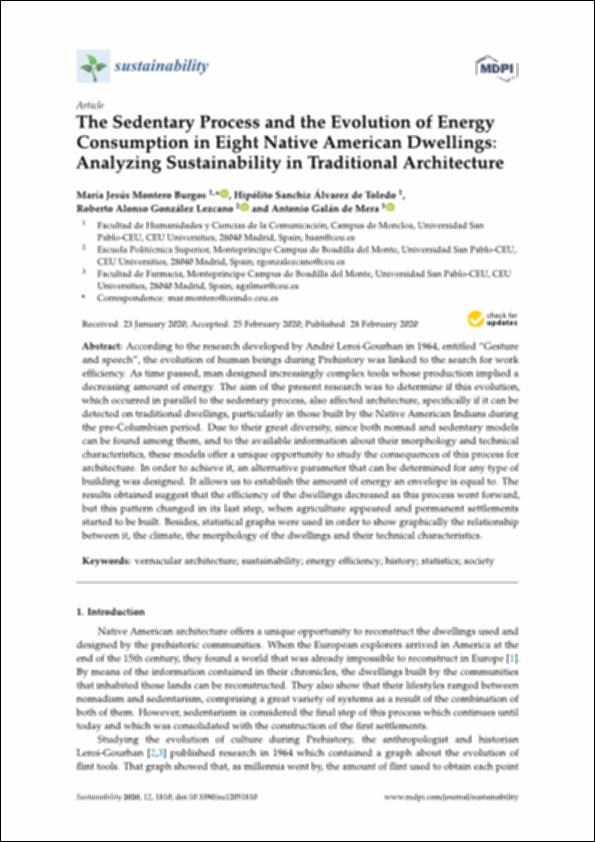Por favor, use este identificador para citar o enlazar este ítem:
http://hdl.handle.net/10637/14293The Sedentary Process and the Evolution of Energy Consumption in Eight Native American Dwellings: Analyzing Sustainability in Traditional Architecture
| Título : | The Sedentary Process and the Evolution of Energy Consumption in Eight Native American Dwellings: Analyzing Sustainability in Traditional Architecture |
| Autor : | Montero Burgos, María Jesús Sanchíz Álvarez de Toledo, Hipólito González Lezcano, Roberto Alonso. Galán de Mera, Antonio |
| Materias: | Vernacular architecture; Sustainability; Energy effciency; History; Statistics; Society |
| Editorial : | MDPI |
| Citación : | Montero Burgos, M.J.; Sanchiz Álvarez de Toledo, H.; González Lezcano, R.A.; Galán de Mera, A. The Sedentary Process and the Evolution of Energy Consumption in Eight Native American Dwellings: Analyzing Sustainability in Traditional Architecture. Sustainability 2020, 12, 1810. https://doi.org/10.3390/su12051810 |
| Resumen : | According to the research developed by André Leroi-Gourhan in 1964, entitled “Gesture and speech”, the evolution of human beings during Prehistory was linked to the search for work e ciency. As time passed, man designed increasingly complex tools whose production implied a decreasing amount of energy. The aim of the present research was to determine if this evolution, which occurred in parallel to the sedentary process, also a ected architecture, specifically if it can be detected on traditional dwellings, particularly in those built by the Native American Indians during the pre-Columbian period. Due to their great diversity, since both nomad and sedentary models can be found among them, and to the available information about their morphology and technical characteristics, these models o er a unique opportunity to study the consequences of this process for architecture. In order to achieve it, an alternative parameter that can be determined for any type of building was designed. It allows us to establish the amount of energy an envelope is equal to. The results obtained suggest that the e ciency of the dwellings decreased as this process went forward, but this pattern changed in its last step, when agriculture appeared and permanent settlements started to be built. Besides, statistical graphs were used in order to show graphically the relationship between it, the climate, the morphology of the dwellings and their technical characteristics. |
| URI : | http://hdl.handle.net/10637/14293 |
| Derechos: | http://creativecommons.org/licenses/by-nc-nd/4.0/deed.es |
| ISSN : | 2071-1050 |
| Fecha de publicación : | 28-feb-2020 |
| Centro : | Universidad San Pablo-CEU |
| Aparece en las colecciones: | Facultad de Humanidades y CC de la Comunicación |
Los ítems de DSpace están protegidos por copyright, con todos los derechos reservados, a menos que se indique lo contrario.


